Abstract
This study addresses the challenge of chitosan (CS) being difficult to dissolve in water due to its highly ordered crystalline structure. Chitosan is modified with chloroacetic acid to reduce its crystallinity and enhance its water solubility. Through single-factor experiments, the optimal conditions for preparing carboxymethyl chitosan film (CMCS) were determined: under conditions of 50 °C, a cellulose substrate (CS) concentration of 18.75 g/L, a NaOH concentration of 112.5 g/L, and a chloroacetic acid concentration of 18.75 g/L, the reaction proceeded for 5 h. Under these conditions, the resulting carboxymethyl chitosan film exhibited the best flocculation effect, forming chitosan films in water that had flocculation activity toward mung bean starch protein wastewater. The successful introduction of carboxyl groups at the N and O positions of the chitosan molecular chain, which reduced the crystallinity of chitosan and enhanced its water solubility, was confirmed through analysis using scanning electron microscopy (SEM), X-ray diffraction (XRD), and Fourier transform infrared spectroscopy (FTIR). The prepared carboxymethyl chitosan film (CMCS) was applied in the flocculation recovery of protein. Through single-factor and response surface experiments, the optimal process conditions for flocculating and recovering protein with CMCS were determined: a CMCS dosage of 1.1 g/L, a reaction time of 39.6 min, a reaction temperature of 42.7 °C, and a pH of 5.2. Under these conditions, the protein recovery rate reached 56.97%. The composition and amino acid profile of the flocculated product were analyzed, revealing that the mung bean protein flocculated product contained 62.33% crude protein. The total essential amino acids (EAAs) accounted for 52.91%, non-essential amino acids (NEAAs) for 47.09%, hydrophobic amino acids for 39.56%, and hydrophilic amino acids for 12.67%. The ratio of aromatic to branched-chain amino acids was 0.31, and the ratio of basic to acidic amino acids was 1.68. These findings indicate that the recovered product has high surface activity and good protein stability, foaming ability, and emulsifying properties.
1. Introduction
Chitin, as the second-largest renewable organic resource globally, is naturally produced at a rate of 100 million tons annually. Its deacetylation product, chitosan, has become a key focus of research in material science due to its abundant resources, easy preparation, and inherent properties as a natural polymer [1,2,3,4,5]. Chitosan faces significant technical barriers in practical applications, primarily due to the limitations imposed by its inherent physicochemical properties. Its highly ordered crystalline structure makes it difficult to dissolve in water, and its insufficient solubility in conventional solvent systems severely restricts its processability [6]. These intrinsic defects prevent the full exploitation of the material’s functional properties, making it necessary to overcome application bottlenecks through chemical modification or physical modification techniques to enhance its structure and functionality [7]. Carboxylation modification of chitosan, as a typical method to enhance its hydrophilic properties, mainly involves introducing carboxyl or carboxylate groups into the molecular chain, making it an amphoteric material. This modification expands the material’s range of applications [8,9,10]. Among carboxymethyl derivatives, O-carboxymethyl chitosan, N-carboxymethyl chitosan, and N, O-carboxymethyl chitosan can be selectively synthesized based on differences in reaction sites. The preparation of O-type and N, O-type derivatives requires completion in a 2-propanol/strong base system, where the alkaline environment activates the hydroxyl group and promotes the nucleophilic substitution reaction. In contrast, N-type derivatives are directed through the high nucleophilic activity of the amine group, which undergoes condensation with acetaldehyde in an aqueous medium and is subsequently reduced by sodium borohydride [11,12]. Dong et al. [13] demonstrated that constructing a Schiff base structure between phthalic anhydride and the C6 hydroxyl group of chitosan can generate a high density of carboxyl groups. The adsorption capacity of the product is significantly enhanced, primarily due to the ion exchange and chelation mechanisms between the surface primary amines and carboxyl groups.
Mung bean is an annual warm-season leguminous crop and a plant of the Cowpea genus in the Leguminous family. It is often rotated with cereal crops such as wheat and rice. It originated in China and has a cultivation history of more than 2000 years in China [14,15,16,17]. Mung beans are rich in nutrients, containing various essential components such as protein, starch, dietary fiber, and fats. The protein content is approximately 20%, the starch content around 45%, and the levels of dietary fiber and fat are also relatively high [18,19]. Longkou vermicelli, produced from mung beans using traditional techniques, is renowned for its excellent taste characteristics. Its production has reached a significant scale in Zhaoyuan, Shandong Province, China [20,21,22]. The sour liquid sedimentation method represents the traditional process for manufacturing mung bean vermicelli. A notable environmental concern associated with this method is the substantial volume of wastewater generated, with approximately 10 tons of production wastewater discharged per ton of starch processed in vermicelli factories [23,24,25,26]. Mung bean wastewater contains approximately 1.1% protein and a significant amount of carbohydrates. While the starch in mung beans is primarily used in the production of vermicelli, a substantial amount of protein and carbohydrates are wasted. Studies have shown that mung bean protein has high nutritional value, being rich in amino acids such as methionine, leucine, and lysine, making it highly valuable for recovery [27,28,29,30,31]. Although chitosan-based flocculants have been extensively investigated, their application for targeted protein recovery in legume processing wastewater remains significantly underexplored. Existing literature on chitosan modification predominantly focuses on enhancing solubility or adsorbing heavy metals/general pollutants, lacking purpose-driven optimization strategies for efficient protein flocculation and recovery in mung bean wastewater [32]. This study employs modified CMCS to efficiently recover proteins from wastewater via flocculation technology, addressing the issue of protein resource wastage. The composition and amino acid profile of the flocculated recovery products are analyzed to evaluate their nutritional characteristics and functional properties [33,34]. This provides a scientific basis for the subsequent application of the recovered proteins, such as in food or industrial raw materials.
2. Materials and Methods
2.1. Materials Preparation
2.1.1. Preparation of CMCS
The carboxymethylation reaction of chitosan (CS) primarily occurs at the hydroxyl and amino groups of chitosan. In this study, N, O-carboxymethyl chitosan film was prepared, and the reaction equation is as Figure 1:

Figure 1.
Chitosan hydroxymethylation reaction.
A measured quantity of 3 g of CS was placed into a three-necked round-bottom flask. A total of 160 mL of isopropanol (IPA) was added, and the mixture was homogenized. Subsequently, a calculated mass of sodium hydroxide (NaOH) was added to the flask to adjust the pH to 4. The mixture was heated to 50 °C and stirred at this temperature for 30 min. Chloroacetic acid was prepared by dissolving it in 35 mL of isopropanol (IPA). This solution was then added to the three-necked flask in five separate portions, with each addition spaced 4 min apart. Following the complete addition, the reaction mixture was maintained at 50 °C under continuous stirring for 300 min. Upon completion, the resulting solution was transferred into a beaker and washed three times with anhydrous ethanol to ensure sufficient precipitation. The supernatant was discarded, and the precipitate was dried at 60 °C in a forced-air drying oven. The final product obtained was the N, O-carboxymethyl chitosan film (CMCS).
2.1.2. Preparation of Mung Bean Vermicelli Wastewater
Mung beans purchased from the supermarket were used, and a juice extraction was performed at a mass ratio of 1:17 (mung beans: distilled water) using a juicer. The resulting solution was then filtered through multiple layers of cheesecloth. The filtered solution was allowed to stand at room temperature for 2 h to settle, after which the precipitate was discarded. The pH was adjusted to 6 using hydrochloric acid, and the solution was centrifuged at 4000 rpm for 30 min using a desktop high-speed centrifuge. The resulting supernatant is the simulated vermicelli wastewater. The protein content of the simulated wastewater is approximately 11 g/L, and the pH is 6. The primary pollutant components consist predominantly of soluble mung bean protein, with a minor proportion of carbohydrates. Although the concentration in the simulated wastewater was higher than that found in actual wastewater, the chemical characteristics of the target pollutants were effectively replicated through concentration and extraction techniques.
2.2. Determination Method
2.2.1. Protein Determination
The protein content in the experiment was determined using the Biuret method. The standard curve is shown in Figure 2. The procedure is as follows:
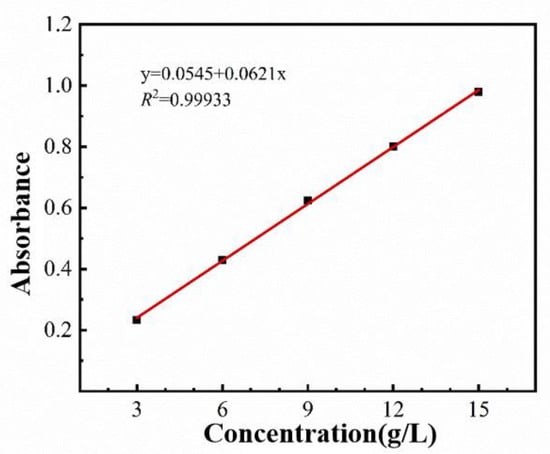
Figure 2.
Standard curve of protein concentration.
Standard crystalline bovine serum albumin (BSA) was accurately measured to prepare a series of standard protein solutions at the required concentrations. Five different concentrations of the standard protein solution were added to test tubes labeled 1 to 5, respectively. An additional test tube labeled 0 was prepared as a blank control. A total of 1.5 g of anhydrous copper (II) sulfate and 6 g of potassium sodium tartrate were precisely weighed, dissolved in 500 mL of deionized water, and stirred thoroughly. The solution was transferred into a 1 L volumetric flask. Subsequently, 300 mL of 10% NaOH solution was prepared and slowly poured along the inner wall of the flask while stirring gently. The solution was then diluted to 1 L with deionized water, mixed thoroughly, and stored for use as the Biuret reagent. The Biuret reagent was added to each of the six test tubes (including the blank), and the tubes were incubated in a 30 °C water bath with gentle shaking for 30 min. Absorbance values were measured at 540 nm using a UV–Visible spectrophotometer, with the 0 tube serving as the blank. The absorbance values of tubes 1–5 were recorded, and a standard calibration curve was constructed based on these data.
2.2.2. Protein Recovery Rate Calculation Method
The protein recovery rate in this study is calculated based on the protein concentration obtained, as shown in Formula (1):
In the formula, the following applies:
- is the protein recovery rate (%);
- C0 is the initial concentration (g/L);
- C1 is the concentration after recovery (g/L).
2.3. Characterization
During testing, the samples were first fixed onto the specimen stage using black conductive adhesive and then gold-coated before further analysis. Scanning Electron Microscopy (SEM) observations were conducted at magnifications of 100× and 500×. Fourier Transform Infrared Spectroscopy (FTIR) was employed to investigate the molecular structure and chemical bonds of the substances. For the FTIR analysis, the samples were dried, ground, and placed in a mortar, to which potassium bromide (pre-dried at 110 °C for over 4 h) was added. The mixture was quickly ground evenly, sampled, and compressed into pellets. The samples were then characterized using a Thermo Scientific IS5 FTIR spectrometer (Thermo Fisher Scientific, Waltham, MA, USA).
For X-ray Diffraction (XRD) analysis, the samples were dried and ground to a 200–325 mesh powder, placed in the circular groove of a glass slide, and compressed into a pellet. The glass slide was then placed in an XRD-6100 X-ray diffractometer (Shimadzu Corporation, Kyoto, Japan) and scanned at a speed of 5°·min−1 with a 2θ range of 5–60° for characterization.
2.4. CMCS Recovery of Protein from Vermicelli Wastewater
In the optimization experiment for the CMCS flocculation and recovery of protein from vermicelli wastewater, 100 mL of wastewater was taken, and CMCS prepared under optimal conditions was used. The reaction mixture was maintained at controlled temperatures of 20, 30, 40, 50, and 60 °C, with the pH adjusted to 3, 4, 5, 6, and 7, respectively, under continuous stirring. Following reaction periods of 20, 30, 40, 50, and 60 min, aliquots were centrifuged at 4000 r/min for 15 min. The supernatant was then collected for the determination of protein concentration. Using the protein recovery rate as the indicator, the effects of the CMCS dosage, pH, reaction time, and reaction temperature on the protein recovery rate were analyzed [35]. Additionally, Design Expert (Box–Behnken) was used for response surface methodology to perform the corresponding experiments, investigating the interactions between different influencing factors and determining the optimal conditions for the recovery process.
2.5. Flocculation Product Analysis
2.5.1. Composition Analysis
Moisture content: Determined by the direct drying method as outlined in GB 5009.3-2016, moisture content is determined by utilizing the physical properties of water in food samples. Under standard atmospheric pressure (101.3 kPa) at 101–105 °C, volatile components are removed through evaporation. This process eliminates hygroscopic water, partial water of crystallization, and other volatile substances under these conditions. The moisture content is then calculated from the weight loss measured before and after drying.
Protein content: Measured using the Kjeldahl method as specified in GB 5009.5-2016, protein in food samples is decomposed under catalytic heating conditions. The liberated ammonia reacts with sulfuric acid to form ammonium sulfate. Subsequent alkaline distillation releases free ammonia, which is absorbed in boric acid solution and subsequently titrated with standardized sulfuric or hydrochloric acid solution. The nitrogen content is calculated based on acid consumption, and the protein content is then determined by multiplying this value by an appropriate conversion factor.
Ash content: Determined by the total ash content method for food as described in GB 5009.4-2016, ash refers to the inorganic mineral constituents remaining after the incineration of a food sample. The ash content is determined gravimetrically through ignition, cooling, and subsequent weighing, and is expressed as a percentage of the original sample mass.
Crude starch: Measured using the polarimetric method as outlined in GB/T 20378-2006, this method comprises two intermediate analytical steps: a portion of the sample undergoes hydrolysis with dilute hydrochloric acid, followed by clarification and filtration prior to polarimetric determination. A second portion is subjected to extraction using an ethanol solution (40% v/v) to isolate soluble sugars and low-molecular-weight polysaccharides. The starch content of the sample is calculated by multiplying the difference between the two measurements by a predetermined conversion factor.
2.5.2. Amino Acid Composition Determination
First, the sample is homogenized. A weighed amount of 0.3452 g of the processed sample is then added to a sodium citrate solution with a pH of 2.2, and the volume is adjusted to 50 mL. The solution is filtered through a 0.22 µm membrane filter. The resulting solution is then analyzed using an amino acid analyzer (LA8080, Hitachi High-Tech Science Corporation, Tokyo, Japan), with detection wavelengths set at 570 nm and 440 nm.
3. Results and Discussion
3.1. Optimization of CMCS Preparation Process
In order to obtain the carboxymethyl chitosan film (CMC) with optimal flocculation performance, this section focuses on the protein recovery rate as the indicator. Four factors were mainly controlled: the amount of CS, NaOH, chloroacetic acid, and reaction time. The flocculation effect of CMCS prepared under different levels of each factor was examined [36].
In the optimization experiment for the preparation process, a uniform flocculation procedure was applied: 100 mL of wastewater was treated by adding 75 mg of prepared CMCS at 50 °C, adjusting the pH to 4. The mixture was stirred at 100 rpm for 3 min, followed by stirring at 50 rpm for 8 min. Afterward, the reaction continued for 30 min. The mixture was then centrifuged at 4000 rpm for 15 min, and the supernatant was collected to measure the protein concentration. Each experiment was repeated three times, and the main factors were optimized through orthogonal testing to determine the best preparation conditions.
3.1.1. Effect of CS Amount
The reaction system maintained a constant volume of 160 mL of isopropanol solvent. All reactant dosages were calculated based on this solvent volume to determine their concentrations. Under the conditions of maintaining the NaOH concentration at 112.5 g/L, the chloroacetic acid concentration at 12.5 g/L, and the reaction time at 5 h, five concentration levels of CS were selected (12.5 g/L, 15.625 g/L, 18.75 g/L, 21.875 g/L, and 25 g/L) to investigate the effect of CS dosage on the protein recovery efficiency during the preparation of CMCS.
The effect of the CS dosage on the protein recovery rate is shown in Figure 3. The maximum protein recovery rate of 32.61% was achieved at a CS concentration of 18.75 g/L. The protein recovery rate increased when the CS concentration was below 18.75 g/L, but decreased when the concentration exceeded this value. At lower CS concentrations, the CMCs exhibited a limited capacity to treat proteins in the wastewater, rendering them unable to recover substantial amounts of protein. Conversely, at excessively high CS concentrations, the solvent was insufficient to achieve complete alkalization, leading to severe solidification. This phenomenon hindered the effective progression of the reaction, resulting in reduced flocculation efficiency of the coagulant and consequently lower protein recovery [37]. Therefore, the optimal CS concentration for preparing CMCs was determined to be 18.75 g/L.
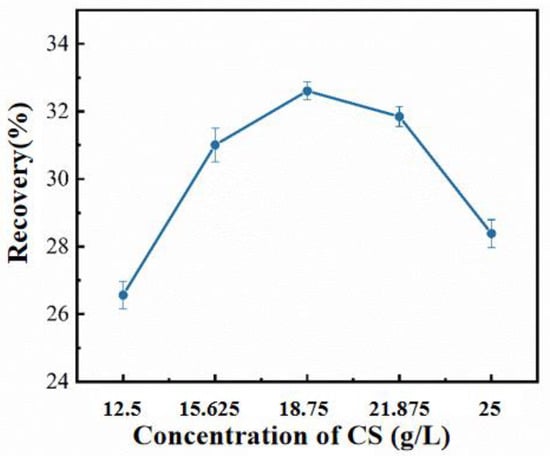
Figure 3.
The influence of chitosan concentration on protein recovery rate.
3.1.2. Effect of NaOH Amount
The reaction system maintained a constant volume of 160 mL of isopropanol solvent. The dosages of all reactants were calculated based on this solvent volume to determine their concentrations. Under conditions maintaining a CS concentration of 18.75 g/L, a chloroacetic acid concentration of 12.5 g/L, and a reaction time of 5 h, five dosage levels of NaOH were selected (75 g/L, 93.75 g/L, 112.5 g/L, 131.25 g/L, and 150 g/L) to investigate the effect of NaOH amount on the protein recovery efficiency during the preparation of CMCS.
The effect of NaOH dosage on the protein recovery rate is shown in Figure 4. A maximum protein recovery rate of 35.28% was achieved at an NaOH concentration of 112.5 g/L. The protein recovery rate increased when the NaOH concentration was below 112.5 g/L, but decreased when the concentration exceeded this value. Alkaline conditions are a crucial prerequisite for the carboxylation reaction to proceed. Insufficient alkali concentration hindered the normal progression of the carboxylation reaction, resulting in lower protein recovery. Conversely, excessive NaOH concentration led to a decrease in chloroacetic acid concentration, thereby impeding the reaction between CS and chloroacetic acid. Furthermore, excessively high NaOH concentration promoted the increased occurrence of side reactions, which was detrimental to the modification of CS [38]. Therefore, the optimal NaOH concentration for preparing CMCs was determined to be 112.5 g/L.
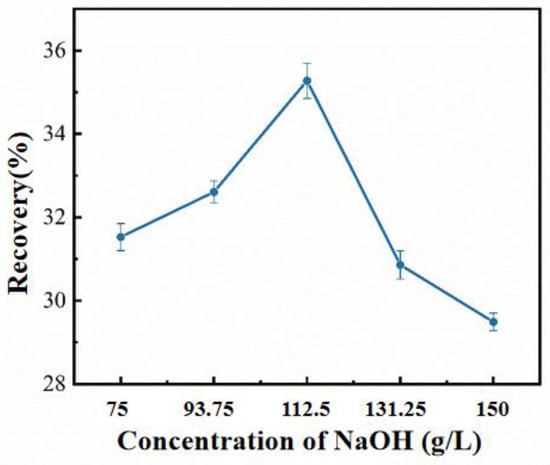
Figure 4.
The influence of sodium hydroxide concentration on protein recovery rate.
3.1.3. Effect of Chloroacetic Acid Amount
The reaction system maintained a constant solvent volume of 160 mL of isopropanol. All reactant concentrations were calculated based on this volume. Under conditions maintaining a cellulose substrate (CS) concentration of 18.75 g/L, a NaOH concentration of 112.5 g/L, and a reaction duration of 5 h, five dosage levels of chloroacetic acid were investigated (6.25 g/L, 12.5 g/L, 18.75 g/L, 25 g/L, and 31.25 g/L) to investigate the effect of chloroacetic the acid amount on the protein recovery efficiency during the preparation of CMCS.
The effect of chloroacetic acid dosage on the protein recovery rate is presented in Figure 5. A maximum protein recovery rate of 39.48% was achieved at a chloroacetic acid concentration of 18.75 g/L. Below this concentration, protein recovery increased with the rising chloroacetic acid concentration. This occurred because the alkalized cellulose substrate (CS) provided a fixed amount of reaction substrate; the increased chloroacetic acid dosage enhanced the degree of carboxymethylation on CS, thereby improving protein recovery. Conversely, at concentrations exceeding 18.75 g/L, the rate of carboxymethylation reaction decreased with the increasing chloroacetic acid concentration. This is due to the reduction in the carboxymethylation reaction rate, as the addition of excess chloroacetic acid alters the pH of the solution. Over-addition leads to the system becoming neutral or acidic, which inhibits the occurrence of the carboxymethylation reaction [39].
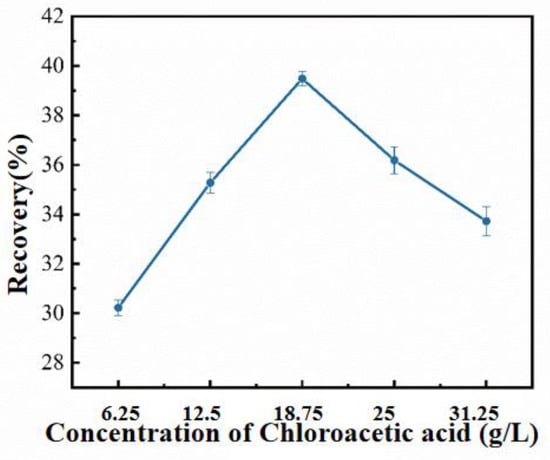
Figure 5.
The influence of chloroacetic acid concentration on protein recovery rate.
3.1.4. Effect of Reaction Time
The reaction system maintained a constant volume of 160 mL of isopropanol solvent. All reactant concentrations were calculated based on this solvent volume. Experimental conditions were maintained at constant concentrations of 18.75 g/L cellulose substrate (CS), 112.5 g/L NaOH, and 18.75 g/L chloroacetic acid. For chloroacetic acid, five levels of reaction time were selected (1 h, 3 h, 5 h, 7 h, and 9 h) to investigate the effect of the reaction time on the protein recovery efficiency during the preparation of CMCS.
As shown in Figure 6, when the reaction time is 5 h, the protein recovery rate reaches its maximum value of 39.48%. Between 1 and 5 h, the protein recovery rate gradually increases. However, when the reaction time exceeds 5 h, the protein recovery rate starts to decrease. When the reaction time is too short, the carboxymethylation reaction between chloroacetic acid and CS is incomplete, resulting in poor flocculation performance and low protein recovery. On the other hand, when the reaction time is too long, the volatility of isopropanol hinders the carboxymethylation reaction, leading to a decrease in the protein recovery. Based on these findings, the optimal reaction time for preparing CMCS is determined to be 5 h.
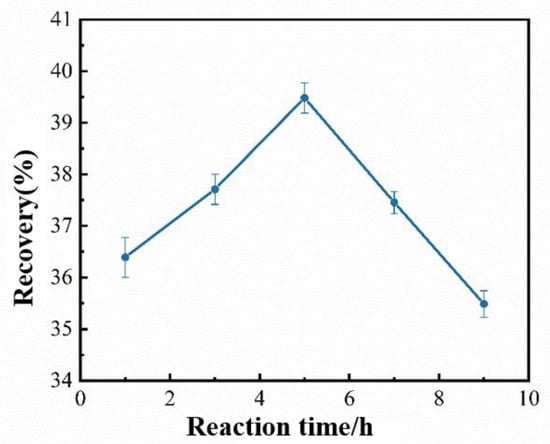
Figure 6.
Effect of reaction time on protein recovery rate.
3.2. CMCS Characterization
3.2.1. SEM: Scanning Electron Microscopy Analysis
The microscopic morphological characteristics of CMCS and CS were studied through SEM, as shown in Figure 7.
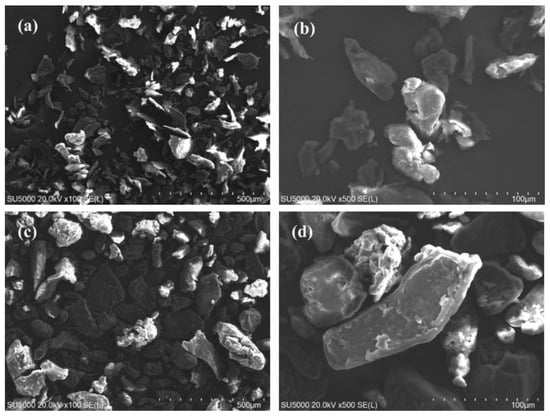
Figure 7.
SEM images of CS (a,b) and CMCS (c,d).
Figures (a) and (b) show the SEM images of CS at 100× and 500× magnification, respectively, while figures (c) and (d) show the SEM images of CMCS prepared under optimal conditions at the same magnifications. From figures (a) and (b), it can be observed that the unmodified CS particles are relatively small, with most displaying a flaky and fine fibrous structure. In contrast, the SEM images of CMCS (c) and (d) clearly show that the particles tend to have a more regular block-like structure, with significantly larger particle sizes, approximately 2–3 times larger than those of CS. These observations indicate that the modified CMCS exhibits distinct differences in particle morphology and size compared to the unmodified CS.
3.2.2. FTIR: Fourier Transform Infrared Spectroscopy Analysis
The chemical bonds and functional groups of CS and CMCS were analyzed through Fourier Transform Infrared Spectroscopy (FTIR), as shown in Figure 8.
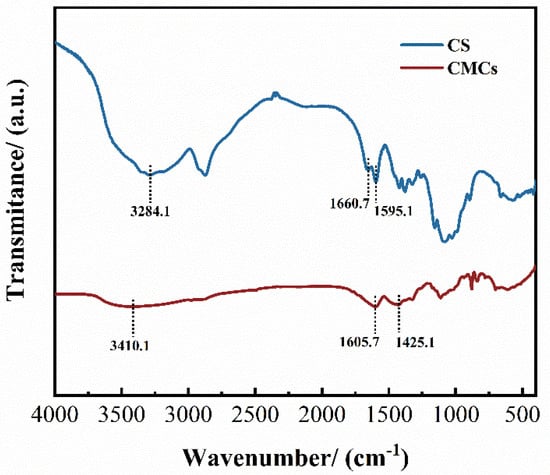
Figure 8.
FTIR spectra of CS and CMCS.
As shown in the figure, compared to CS, the FTIR spectrum of CMCS shows a broadening and weakening of the peak in the 3000–3500 cm−1 range. The peak at 3284.1 cm−1 corresponds to the -NH2 and -OH groups of the CS molecular chain. The shift of the peak to 3410.1 cm−1 in CMCS indicates that hydrogen bonding between -NH2 and -OH is weakened, suggesting that the carboxymethylation reaction occurs through substitution at the -NH2 and -OH sites of the CS molecular chain [40]. The peak at 1595.1 cm−1 in CS represents the N-H bending vibration. This peak merges with the peak at 1660.7 cm−1, resulting in a peak at 1605.7 cm−1, indicating that the product is CMCS formed by carboxymethylation of CS. The peaks at 1605.7 cm−1 and 1425.1 cm−1 correspond to the asymmetric and symmetric stretching vibration absorption peaks of -COO−, respectively, confirming the presence of carboxyl groups and further proving that the product is CMCS.
3.2.3. XRD: X-Ray Diffraction Analysis
The phase crystalline structure of CS and CMCS was analyzed through X-ray diffraction (XRD), as shown in Figure 9.
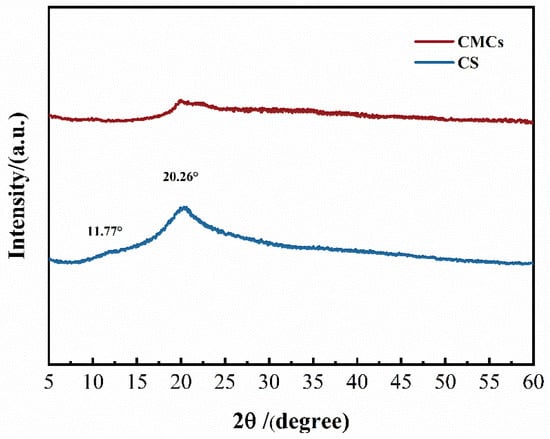
Figure 9.
XRD spectrum of CS and CMCS.
As shown in the figure, CS exhibits two strong diffraction peaks at 11.77° and 20.26°, while CMCS only shows a weak diffraction peak at 20.26°, with the peak at 11.77° having disappeared. The presence of these two peaks is the main reason for the insolubility of CS in water, confirming that the modified CMCS is more easily soluble in water [41]. The figure also indicates that the crystallinity of CMCS is significantly lower than that of CS. This is primarily due to the fact that after carboxymethylation, CMCS lacks amino and hydroxyl groups, making it difficult to form hydrogen bonds between amino and hydroxyl groups. As a result, the crystallinity is reduced, leading to a more loosely structured material that effectively enhances the water solubility of CS.
3.3. Research on the Protein Flocculation Process of Vermicelli Wastewater by CMCS
3.3.1. Effect of CMCS Dosage on Protein Recovery Rate
Under the conditions of a reaction time of 30 min, a reaction temperature of 50 °C, and a reaction system pH of 5, five levels of CMCS dosage were selected (0.5 g/L, 0.75 g/L, 1 g/L, 1.25 g/L, and 1.5 g/L) to investigate the effect of CMCS dosage on protein recovery rate.
The effect of CMCS dosage on protein recovery rate is shown in Figure 10. When the dosage is 1 g/L, the protein recovery rate reaches its maximum value of 49.01%. When the CMCS dosage is less than 1 g/L, the protein recovery rate increases, as the small amount of CMCS is insufficient to fully react with the proteins in the wastewater. As the dosage increases, more thorough contact between CMCS and the proteins occurs, leading to an increase in protein recovery rate. However, when the CMCS dosage exceeds 1 g/L, the protein recovery rate decreases. This is mainly because excessive CMCS forms a stable colloidal suspension in the wastewater, which increases the viscosity and hinders the flocculation reaction, leading to a decrease in protein recovery rate [42]. Based on these findings, the optimal CMCS dosage for the flocculation process is determined to be 1 g/L.
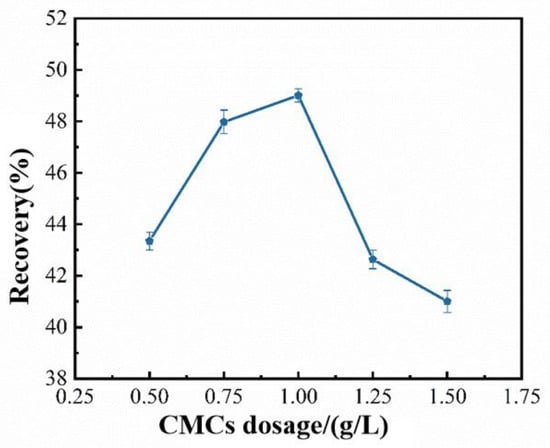
Figure 10.
Effect of CMCS addition amount on protein recovery rate.
3.3.2. Effect of Reaction Time on Recovery Rate
Under the conditions of 1 g/L chitosan dosage, a reaction temperature of 30 °C, and a reaction system pH of 5, five levels of reaction time were selected: 20 min, 30 min, 40 min, 50 min, and 60 min, to investigate the effect of reaction time on protein recovery rate.
The effect of reaction time on protein recovery rate is shown in Figure 11. When the reaction time is 40 min, the protein recovery rate reaches its maximum value of 50.54%. As shown in the figure, when the reaction time is less than 40 min, the protein recovery rate gradually increases with the extension of the reaction time. This is because, in a short period, CMCS cannot fully react with the proteins, and the flocculant’s adsorption capacity on the proteins is relatively low, resulting in a lower recovery rate. As the reaction time increases, the adsorption effect becomes more sufficient, leading to a significant increase in the recovery rate. When the reaction time exceeds 40 min, the protein recovery rate becomes relatively stable, as the adsorption of CMCS on proteins approaches saturation at 40 min, and the recovery rate tends to stabilize with further increases in time [43]. Based on these findings, the optimal reaction time for the CMCS flocculation process is determined to be 40 min.
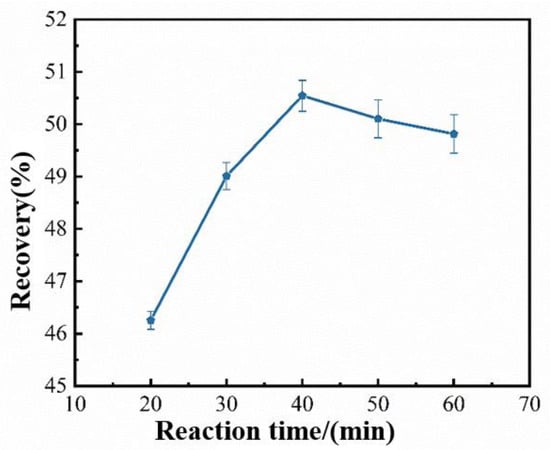
Figure 11.
Effect of reaction time on protein recovery rate.
3.3.3. Effect of Reaction Temperature on Recovery Rate
Under the conditions of 1 g/L chitosan dosage, a reaction time of 40 min, and a reaction system pH of 5, five levels of reaction temperature were selected (20 °C, 30 °C, 40 °C, 50 °C, and 60 °C) to investigate the effect of reaction temperature on protein recovery rate.
The effect of reaction temperature on protein recovery rate is shown in Figure 12. When the reaction temperature is 40 °C, the protein recovery rate reaches its maximum value of 51.65%. As seen in the figure, when the reaction temperature is lower than 40 °C, the recovery rate increases with the rise in temperature. This is because the diffusion efficiency of CMCS in the wastewater is influenced by temperature. A moderate increase in temperature enhances diffusion efficiency, leading to faster molecular collisions of CMCS in the wastewater and improving flocculation performance. However, when the reaction temperature exceeds 40°C, the recovery rate decreases. This is primarily due to the fact that the protein adsorption reaction by the flocculant is exothermic, and excessively high temperatures are unfavorable for the reaction [44]. Based on these findings, the optimal reaction temperature for the CMCS flocculation process is determined to be 40 °C.
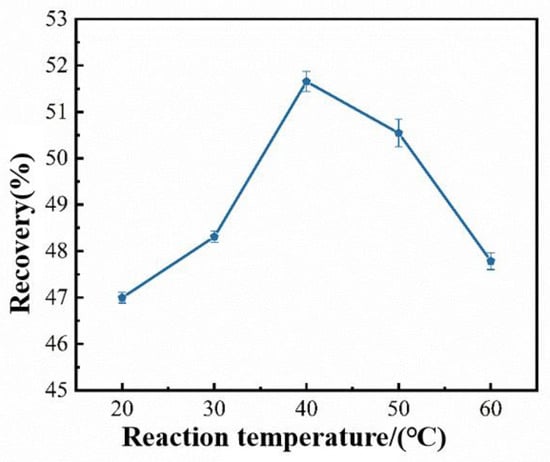
Figure 12.
Effect of reaction temperature on protein recovery rate.
3.3.4. Effect of pH on Recovery Rate
Under the conditions of 1 g/L chitosan dosage, a reaction time of 40 min, and a reaction temperature of 40 °C, five levels of pH were selected (3, 4, 5, 6, and 7) to investigate the effect of pH on the protein recovery rate.
The effect of pH on protein recovery rate is shown in Figure 13. When the pH is 5, the protein recovery rate reaches its maximum value of 51.65%. As seen in the figure, when the pH is lower than 5, the recovery rate increases with the increase in pH. However, when the pH is greater than 5, the recovery rate decreases as the pH increases. This is because the isoelectric point of mung bean protein is approximately 4.5 and 5. When the pH of the wastewater is greater than the isoelectric point, the protein carries a negative charge, while it carries a positive charge when the pH is lower than the isoelectric point. The isoelectric point of the prepared CMCS is approximately 5.5. When the pH is below 5.5, CMCS carries a positive charge, whereas it is negatively charged at pH values above this point. Therefore, at pH 5, electrostatic attraction occurs between the positively charged proteins and the negatively charged CMCS, leading to the formation of complexes and resulting in the highest protein recovery. As the pH increases, both the proteins and CMCS become negatively charged, resulting in electrostatic repulsion and a consequent decrease in recovery efficiency [45]. In summary, the pH of the system alters the surface charge properties of both CMCS and proteins, thereby influencing their interactions. Thus, the optimal pH for the flocculation process using CMCS is determined to be 5.
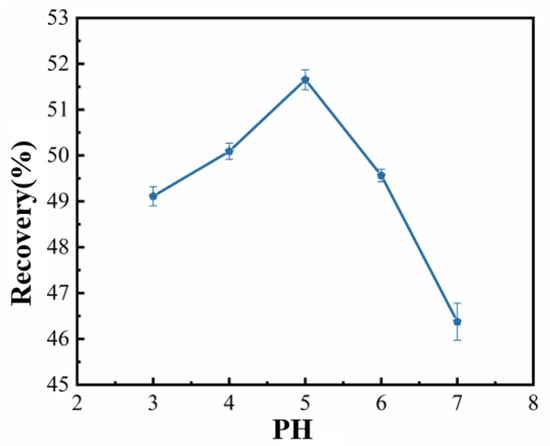
Figure 13.
Effect of the amount of pH on protein recovery rate.
3.3.5. Response Surface Methodology for CMCS Flocculation and Protein Recovery from Vermicelli Wastewater
- (1)
- Response Surface Experimental Design
Response surface methodology (RSM) design and analysis were conducted using Design-Expert software. Based on the previously completed single-factor experiments, the main factors were selected for this experiment. The factors chosen for this study were CMCS dosage (A), reaction time (B), reaction temperature (C), and pH (D), with three optimal and adjacent levels. The software’s Box–Behnken design was used for a 4-factor, 3-level response surface experimental design, with protein recovery rate as the response variable. The response surface experimental design table is shown in Table 1.

Table 1.
Response surface test design table.
- (2)
- Response Surface Experimental Design and Results
Based on the experimental design table, 29 experimental runs were designed using the Box–Behnken experimental design principles. The experiments were conducted according to the corresponding factor levels to obtain the response values. The response surface experimental design and results for protein recovery rate are shown in Table 2.

Table 2.
Design and results of response surface experiment.
The experimental results were analyzed using Design Expert, and a model fitting optimization was performed for the four factors. The results indicated that A, B, C, and D all fit a quadratic model. The quadratic polynomial for this model is as follows, and the model was evaluated based on the related correlation coefficient R2. The adjusted R2 value for this model is 0.9631, which is close to 1, indicating that the experimental data closely matches the predicted values.
Y = 56.37 + 1.68 × A − 0.3350 × B + 0.3492 × C + 2.23 × D + 0.3225 × AB + 0.9100 × AC − 0.0.8325 × AD − 0.1900 × BC − 0.5725 × BD − 0.7925 × CD − 2.4 × A2 − 1.71 × B2 − 1.65 × C2 − 3.11 × D2
- (3)
- Regression Analysis
The regression analysis results of this experiment are shown in Table 3. From the table, it can be observed that the F-value and p-value of the model are provided, which are used to evaluate the significance of the model.

Table 3.
ANOVA results of RSM.
The p-value of the experimental model is less than 0.0001, indicating a highly significant level. The lack of fit value is 0.5623, which is greater than 0.05, indicating that the lack of fit is not significant, suggesting that this model provides a good fit for the experimental data. The significance of the influencing factors can be assessed by the F-value, where a higher F-value represents greater significance. The influencing factors in this experimental model, ranked by significance from highest to lowest, are pH > dosage > reaction temperature > reaction time.
For the quadratic equation model error statistical analysis, the model’s R2 = 0.9815 and R2 adjusted = 0.9631, indicating that 96.31% of the experimental values align with the model. The precision is 27.547, which is greater than 4, confirming the model’s rationality. The coefficient of variation (CV) is less than 10%, indicating high experimental accuracy, with a CV value of 0.98% in this experiment. The above analysis shows that using this model to predict the conditions for protein recovery is feasible.
- (4)
- Optimization Model Response Surface Analysis
The three-dimensional response surface plots of the regression equation for the response surface model are shown in Figure 14, Figure 15, Figure 16 and Figure 17.
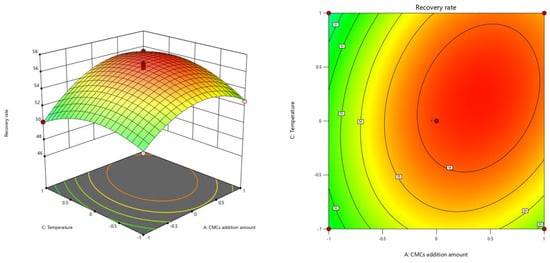
Figure 14.
Effect of interaction between CMCS addition amount and reaction temperature on average growth rate.
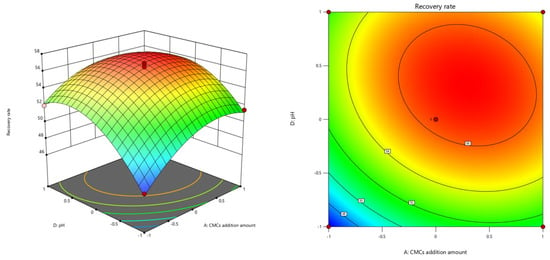
Figure 15.
Effect of interaction between CMCS addition amount and pH on average growth rate.
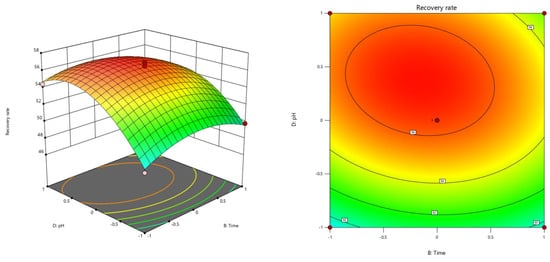
Figure 16.
Effect of interaction between reaction time and pH on average growth rate.
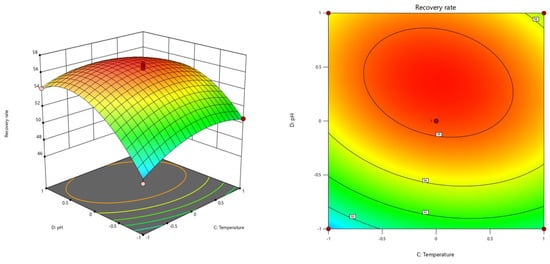
Figure 17.
Effect of interaction between reaction temperature and pH on average growth rate.
The figures represent the response surface model for four factors: carboxymethyl CMCS dosage (A), reaction time (B), reaction temperature (C), and pH (D). They visually illustrate the pairwise interactions between factors and the degree of their influence on the reaction outcomes.
From the 3D response surface plots, the impact of the four response factors can be observed, with their significance ranked as follows: pH > dosage > reaction temperature > reaction time. Analysis using Design Expert 12 software yields the optimal process conditions: a dosage of 1.1 g/L, reaction time of 39.6 min, reaction temperature of 42.7 °C, and pH of 5.2, resulting in a protein recovery rate of 56.97%.
The isoelectric point of mung bean protein is approximately 4.5–5. At a pH above 5, it carries a negative charge. The isoelectric point of carboxymethyl chitosan (CMCS) is approximately 5.5. At a pH below 5.5, CMCS is positively charged, while at a pH above 5.5, it is negatively charged. Consequently, at pH 5.2, the protein is negatively charged, and CMCS is positively charged. They interact via electrostatic attraction, leading to the formation of flocs.
3.4. Flocculation Product Analysis
The recovered flocculation product, after protein recovery, is collected and subjected to freeze-drying. The freeze-dried product is then ground into a powder and stored in sealed bags. The composition analysis and amino acid profile of the recovered product are subsequently performed.
3.4.1. Composition Analysis of the Product
The composition of the recovered product was analyzed using national standard methods, as shown in Table 4. From the table, it can be seen that the crude protein content in the recovered product accounts for 62.33% of the total tested content, while crude starch and ash make up 9.26% and 21.52%, respectively. Additionally, the product contains 6.89% moisture.

Table 4.
Analysis of recovered product components.
3.4.2. Amino Acid Composition Determination
The amino acid composition of the recovered product was analyzed, as shown in Table 5. According to the test results, the recovered product contains 10 essential amino acids and 7 non-essential amino acids. Among them, the total amount of essential amino acids (EAAs) is 52.91%, and the total amount of non-essential amino acids (NEAAs) is 47.09%. The total amount of hydrophobic amino acids is 39.56%, and the total amount of hydrophilic amino acids is 12.67%. This suggests that the recovered product has high surface activity.

Table 5.
Amino acid composition of recovered product.
The ratio of aromatic amino acids to branched-chain amino acids reflects the stability of the protein, and this ratio in the recovered product is 0.31, indicating good protein stability. The ratio of basic to acidic amino acids reflects the functional strength of the protein. From the table, it can be seen that the recovered product has a basic/acidic amino acid ratio of 1.68, suggesting that it exhibits good properties in terms of foaming ability and emulsifying capacity [46,47].
4. Conclusions
Carboxymethylation modification of chitosan resulted in N, O-carboxymethyl chitosan film, which successfully improved its poor water solubility and optimized its flocculation performance. The optimal preparation conditions for N,O-carboxymethyl chitosan membranes were determined as follows: a cellulose substrate (CS) concentration of 18.75 g/L, a NaOH concentration of 112.5 g/L, and a chloroacetic acid concentration of 18.75 g/L, with a 5-hour reaction time. Membranes synthesized under these parameters exhibited optimal flocculation efficiency. N, O-carboxymethyl chitosan film demonstrated a good flocculation effect on protein in vermicelli wastewater. The optimized flocculation process conditions are as follows: CMCS prepared under the optimal conditions were added to the wastewater, followed by stirring at 100 r/min for 3 min and 50 r/min for 8 min, with a CMCS dosage of 1.1 g/L, a pH adjusted to 5.2, a reaction temperature set to 42.7 °C, and a reaction time of 5 h. Under these conditions, the protein recovery rate from flocculation was 56.97%, achieving resource recovery. The recovered product exhibited good stability and functional properties.
Author Contributions
Conceptualization, Z.L.; software, G.L.; formal analysis, X.Z.; investigation, W.L.; data curation, T.Y.; methodology and writing—original draft preparation, J.Z.; writing—review and editing, Y.W.; supervision, Z.L.; resources, validation, Z.W.; project administration, and funding acquisition, J.Z. All authors have read and agreed to the published version of the manuscript.
Funding
The project was supported by the key R&D Program of the Department of Science and Technology of Jilin Province, China (No. 20200403007SF).
Institutional Review Board Statement
Not applicable since studies not involving humans or animals.
Informed Consent Statement
Not applicable.
Data Availability Statement
Data are contained within the article.
Conflicts of Interest
The authors declare no conflict of interest.
References
- Abu-Saied, M.; Wycisk, R.; Abbassy, M.M.; El-Naim, G.A.; El-Demerdash, F.; Youssef, M.; Bassuony, H.; Pintauro, P.N. Sulfated chitosan/PVA absorbent membrane for removal of copper and nickel ions from aqueous solutions—Fabrication and sorption studies. Carbohydr. Polym. 2017, 165, 149–158. [Google Scholar] [CrossRef] [PubMed]
- Hahn, T.; Tafi, E.; Paul, A.; Salvia, R.; Falabella, P.; Zibek, S. Current state of chitin purification and chitosan production from insects. J. Chem. Technol. Biotechnol. 2020, 95, 2775–2795. [Google Scholar] [CrossRef]
- Xiang, W.; Cao, H.; Tao, H.; Jin, L.; Luo, Y.; Tao, F.; Jiang, T. Applications of chitosan-based biomaterials: From preparation to spinal cord injury neuro-prosthetic treatment. Int. J. Biol. Macromol. 2023, 230, 123447. [Google Scholar] [CrossRef] [PubMed]
- Kritchenkov, A.S.; Egorov, A.R.; Yagafarov, N.Z.; Volkova, O.V.; Zabodalova, L.A.; Suchkova, E.P.; Kurliuk, A.V.; Khrustalev, V.N. Efficient reinforcement of chitosan-based coatings for Ricotta cheese with non-toxic, active, and smart nanoparticles. Prog. Org. Coat. 2020, 145, 105707. [Google Scholar] [CrossRef]
- Lichtfouse, E.; Morin-Crini, N.; Fourmentin, M.; Zemmouri, H.; do Carmo Nascimento, I.O.; Queiroz, L.M.; Tadza, M.Y.; Picos-Corrales, L.A.; Pei, H.; Wilson, L.D.; et al. Chitosan for direct bioflocculation of wastewater. Environ. Chem. Lett. 2019, 17, 231–245. [Google Scholar] [CrossRef]
- Sun, Z.-H. Cardiovascular computed tomography in cardiovascular disease: An overview of its applications from diagnosis to prediction. J. Geriatr. Cardiol. 2024, 21, 550–576. [Google Scholar] [CrossRef] [PubMed]
- Sanjari, A.J.; Asghari, M. A Review on Chitosan Utilization in Membrane Synthesis. ChemBioEng Rev. 2016, 3, 134–158. [Google Scholar] [CrossRef]
- Zhou, Y.; Yang, Y.; Wang, D.; Liu, X. Preparation and Characterization of 6-Carboxychitosan. Chem. Lett. 2003, 32, 682–683. [Google Scholar] [CrossRef]
- Kurniasih, M.; Purwati; Cahyati, T.; Dewi, R.S. Carboxymethyl chitosan as an antifungal agent on gauze. Int. J. Biol. Macromol. 2018, 119, 166–171. [Google Scholar] [CrossRef] [PubMed]
- Boamah, P.O.; Huang, Y.; Hua, M.; Zhang, Q.; Wu, J.; Onumah, J.; Sam-Amoah, L.K. Sorption of heavy metal ions onto carboxylate chitosan derivatives—A mini-review. Ecotoxicol. Environ. Saf. 2015, 116, 113–120. [Google Scholar] [CrossRef] [PubMed]
- Diamond, M.; Luciano, A.; Johns, D.; Dunn, R.; Young, P.; Bieber, E. Reduction of postoperative adhesions by N,O-carboxymethylchitosan (NOCC): A pilot study. Fertil. Steril. 2002, 77, S10. [Google Scholar] [CrossRef]
- Shinde, U.; Ahmed, M.H.; Singh, K. Development of Dorzolamide Loaded 6-O-Carboxymethyl Chitosan Nanoparticles for Open Angle Glaucoma. J. Drug Deliv. 2013, 2013, 562727. [Google Scholar] [CrossRef] [PubMed]
- Liu, D.; Cheng, W.; Yu, J.; Ding, Y. Synthesis of carboxyl-introduced chitosan with C2 amine groups protected and its use in copper (II) removal. Water Sci. Technol. 2017, 76, 2095–2105. [Google Scholar] [CrossRef] [PubMed]
- Du, M.; Xie, J.; Gong, B.; Xu, X.; Tang, W.; Li, X.; Li, C.; Xie, M. Extraction, physicochemical characteristics and functional properties of Mung bean protein. Food Hydrocoll. 2018, 76, 131–140. [Google Scholar] [CrossRef]
- Hou, D.; Yousaf, L.; Xue, Y.; Hu, J.; Wu, J.; Hu, X.; Feng, N.; Shen, Q. Mung Bean (Vigna radiata L.): Bioactive Polyphenols, Polysaccharides, Peptides, and Health Benefits. Nutrients 2019, 11, 1238. [Google Scholar] [CrossRef] [PubMed]
- Huang, Z.; Li, Y.; Fan, M.; Qian, H.; Wang, L. Recent advances in mung bean protein: From structure, function to application. Int. J. Biol. Macromol. 2024, 273, 133210. [Google Scholar] [CrossRef] [PubMed]
- Wang, L.; Wang, S.; Luo, G.; Zhang, J.; Chen, Y.; Chen, H.; Cheng, X. Evaluation of the Production Potential of Mung Bean Cultivar “Zhonglv 5”. Agronomy 2022, 12, 707. [Google Scholar] [CrossRef]
- Tarahi, M.; Abdolalizadeh, L.; Hedayati, S. Mung bean protein isolate: Extraction, structure, physicochemical properties, modifications, and food applications. Food Chem. 2024, 444, 138626. [Google Scholar] [CrossRef] [PubMed]
- Qin, L.; Chen, S.; Xie, L.; Yu, Q.; Chen, Y.; Xie, J. Recent advances in Mung bean polysaccharides: Extraction, physicochemical properties and biological activities. Process Biochem. 2022, 121, 248–256. [Google Scholar] [CrossRef]
- Mohan Naik, G.; Abhirami, P.; Venkatachalapathy, N. Mung bean. In Pulses: Processing and Product Development; Springer Nature: Cham, Switzerland, 2020; pp. 213–228. [Google Scholar]
- Feng, Q.; Niu, Z.; Zhang, S.; Wang, L.; Qun, S.; Yan, Z.; Hou, D.; Zhou, S. Mung bean protein as an emerging source of plant protein: A review on production methods, functional properties, modifications and its potential applications. J. Sci. Food Agric. 2023, 104, 2561–2573. [Google Scholar] [CrossRef] [PubMed]
- Li, S.; Feng, X.; Hao, X.; Zhu, Y.; Zou, L.; Chen, X.; Yao, Y. A comprehensive review of mung bean proteins: Extraction, characterization, biological potential, techno-functional properties, modifications, and applications. Compr. Rev. Food Sci. Food Saf. 2023, 22, 3292–3327. [Google Scholar] [CrossRef] [PubMed]
- Yu, S.; Wu, Y.; Li, Z.; Wang, C.; Zhang, D.; Wang, L. Effect of different milling methods on physicochemical and functional properties of mung bean flour. Front. Nutr. 2023, 10, 1117385. [Google Scholar] [CrossRef] [PubMed]
- Li, Z.; Liu, W.; Shen, Q.; Zheng, W.; Tan, B. Properties and qualities of vermicelli made from sour liquid processing and centrifugation starch. J. Food Eng. 2007, 86, 162–166. [Google Scholar] [CrossRef]
- Nguyen, P.B.; Pham, V.T.; Viet Le, H.; Kumar, P.; Meraj, G. Pollution Mitigation in Vermicelli Wastewater: Integrated Fenton and Aerobic Sludge Treatment for Water Quality Improvement. Scientifica 2024, 2024, 8133617. [Google Scholar] [CrossRef] [PubMed]
- Kang, J.; Yang, W.; Shao, Y.; Xuan, N.; Geng, Y.; Bian, F.; Zhang, Y.; Zhang, Y.; Yue, M.; Cao, X.; et al. Feasibility of Using Yeast and Microalgae for Pea Vermicelli Wastewater Treatment: A Staged Process for Pollutant Removal and Resource Recovery. Available online: https://papers.ssrn.com/sol3/papers.cfm?abstract_id=5082771 (accessed on 6 June 2024).
- Liu, F.F.; Li, Y.Q.; Wang, C.Y.; Liang, Y.; Zhao, X.Z.; He, J.X.; Mo, H.Z. Physicochemical, functional and antioxidant properties of mung bean protein enzymatic hydrolysates. Food Chem. 2022, 393, 133397. [Google Scholar] [CrossRef] [PubMed]
- Shrestha, S.; van’t Hag, L.; Haritos, V.S.; Dhital, S. Lentil and Mungbean protein isolates: Processing, functional properties, and potential food applications. Food Hydrocoll. 2022, 135, 108142. [Google Scholar] [CrossRef]
- Moghadam, M.; Salami, M.; Mohammadian, M.; Khodadadi, M.; Emam-Djomeh, Z. Development of antioxidant edible films based on mung bean protein en-riched with pomegranate peel. Food Hydrocoll. 2020, 104, 105735. [Google Scholar] [CrossRef]
- Brishti, F.H.; Chay, S.Y.; Muhammad, K.; Ismail-Fitry, M.R.; Zarei, M.; Karthikeyan, S.; Saari, N. Effects of drying techniques on the physicochemical, functional, thermal, structural and rheological properties of mung bean (Vigna radiata) protein isolate powder. Food Res. Int. 2020, 138, 109783. [Google Scholar] [CrossRef] [PubMed]
- Hou, D.; Feng, Q.; Niu, Z.; Wang, L.; Yan, Z.; Zhou, S. Promising mung bean proteins and peptides: A comprehensive review of preparation technologies, biological activities, and their potential applications. Food Biosci. 2023, 55, 102972. [Google Scholar] [CrossRef]
- Ma, M.M.; Mu, T.H.; Sun, H.N. Research progress of nutritional and healthy potato food processing and high-value utilization of by-products. J. Food Saf. Qual. 2020, 11, 9154–9163. [Google Scholar]
- Liu, J.; Wu, S.; Lu, Y.; Liu, Q.; Jiao, Q.; Wang, X.; Zhang, H. An integrated electrodialysis-biocatalysis-spray-drying process for efficient recycling of keratin acid hydrolysis industrial wastewater. Chem. Eng. J. 2016, 302, 146–154. [Google Scholar] [CrossRef]
- Zheng, K.; Li, H.; Wang, S.; Wang, Y.; Li, A.; Feng, X.; Li, J. Enhanced proteins and amino acids production based on ammonia nitrogen assimilation and sludge increment by the integration of bioadsorption with anaerobic-anoxic-oxic (AAO) process. Chemosphere 2021, 280, 130721. [Google Scholar] [CrossRef] [PubMed]
- Soon, W.L. Valorization of Food Industrial Waste into Protein Amyloid Fibrils for Water and Energy Applications. 2023. Available online: https://dr.ntu.edu.sg/entities/publication/500e7d4a-b794-4221-b5e4-ce94eda28235 (accessed on 26 July 2024).
- Nguyen, P.B.; Le Hoang, V.; Pham, V.T. Treatment of Vermicelli Wastewater by a Combination of Advanced Oxidation and Biological Methods. In Proceedings of the International Conference on Civil and Environmental Engineering, Can Tho, Vietnam, 23–25 November 2023; Volume 19, pp. 496–503. [Google Scholar]
- Xiao, J.; Gu, C.; Zhu, D.; Huang, Y.; Luo, Y.; Zhou, Q. Development and characterization of an edible chitosan/zein-cinnamaldehyde nano-cellulose composite film and its effects on mango quality during storage. LWT 2021, 140, 110809. [Google Scholar] [CrossRef]
- Yan, J.; Guan, Z.Y.; Zhu, W.F.; Zhong, L.Y.; Qiu, Z.Q.; Yue, P.F.; Wu, W.T.; Liu, J.; Huang, X. Preparation of puerarin chitosan oral nanoparticles by ionic gelation method and its related kinetics. Pharmaceutics 2020, 12, 216. [Google Scholar] [CrossRef] [PubMed]
- Taqwa, S.P.; Djunaidi, M.C.; Lusiana, R.A. Synthesis of Chitosan Derivative Compounds Through Chloroacetic Acid and Heparin Grafting and Their Application as Membrane Materials with Polyvinyl Alcohol (PVA). J. Kim. Sains dan Apl. 2022, 25, 412–418. [Google Scholar] [CrossRef]
- Satrio, N.W.; Wardana, I.N.G. Hydrogen production from instant noodle wastewater by organic electrocatalyst coated on PVC surface. Int. J. Hydrogen Energy 2020, 45, 12859–12873. [Google Scholar] [CrossRef]
- Sridang, P.; Wongsawan, C.; Santisukkasaem, U.; Phantaweesub, N. Performance of up-flow anaerobic sludge blanket-membrane bioreactor (UASB-MBR) for treating rice vermicelli and flour wastewater. Desalination Water Treat. 2024, 320, 100705. [Google Scholar] [CrossRef]
- Zhang, S.; Li, J.; Li, J.; Du, N.; Li, D.; Li, F.; Man, J. Application status and technical analysis of chitosan-based medical dressings: A review. RSC Adv. 2020, 10, 34308–34322. [Google Scholar] [CrossRef] [PubMed]
- Zhao, M.; Huang, Z.; Wang, S.; Zhang, L. Ultrahigh efficient and selective adsorption of Au (III) from water by novel Chitosan-coated MoS2 biosorbents: Performance and mechanisms. Chem. Eng. J. 2020, 401, 126006. [Google Scholar] [CrossRef]
- Liu, X.Q.; Zhao, X.X.; Liu, Y.; Zhang, T.A. Review on preparation and adsorption properties of chitosan and chitosan composites. Polym. Bull. 2022, 79, 2633–2665. [Google Scholar] [CrossRef]
- Hu, T.L. Treatment of vermicelli wastewater by an acid-tolerant, starch-degrading yeast. Biol. Wastes 1989, 28, 163–174. [Google Scholar] [CrossRef]
- Sheng, Y.; Zhang, H.; Song, X.; Wang, Z.; Wang, X.; Li, Y. Comparative study on foaming and foam stability of multiple mixed systems of fluorocarbon, hydrocarbon, and amino acid surfactants. J. Surfactants Deterg. 2023, 26, 683–691. [Google Scholar] [CrossRef]
- Sá, A.G.; Pacheco, M.T.; Moreno, Y.M.; Carciofi, B.A. Cold-pressed sesame seed meal as a protein source: Effect of processing on the protein digestibility, amino acid profile, and functional properties. J. Food Compos. Anal. 2022, 111, 104634. [Google Scholar] [CrossRef]
Disclaimer/Publisher’s Note: The statements, opinions and data contained in all publications are solely those of the individual author(s) and contributor(s) and not of MDPI and/or the editor(s). MDPI and/or the editor(s) disclaim responsibility for any injury to people or property resulting from any ideas, methods, instructions or products referred to in the content. |
© 2025 by the authors. Licensee MDPI, Basel, Switzerland. This article is an open access article distributed under the terms and conditions of the Creative Commons Attribution (CC BY) license (https://creativecommons.org/licenses/by/4.0/).